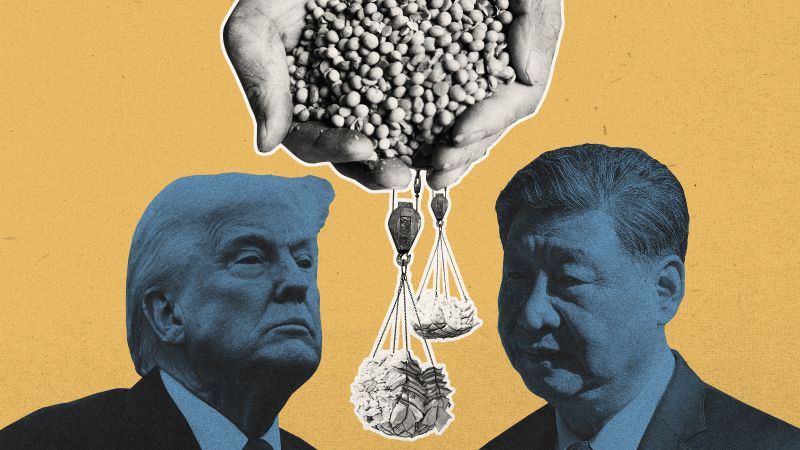China Trade War: Did Trump's Policies Hurt His Own Voters?
Editor's Note: New economic data reveals the complex impact of the Trump administration's trade war with China on American workers.
This article explores the surprising consequences of the Trump administration's trade policies, specifically focusing on how the tariffs imposed on Chinese goods may have disproportionately affected the very voters who supported the President. We'll delve into the economic data, examining the impact on key sectors and exploring the long-term implications of this trade conflict.
Why This Matters: The 2016 presidential election saw a significant surge in support for Donald Trump among working-class voters in traditionally Democratic-leaning states. Many of these voters felt economically left behind by globalization and existing trade agreements. Understanding whether the trade war with China benefited or harmed these crucial demographic groups is vital to understanding the complexities of economic policy and its impact on the electorate. This analysis will examine the effects on manufacturing, agriculture, and other key sectors that form the economic backbone of many Trump-supporting communities.
| Key Takeaways |
|---|
| Tariffs impacted key industries in "red states" |
| Farm bankruptcies increased post-tariff implementation |
| Consumer prices rose, impacting low-income households |
| Long-term economic effects still unfolding |
China Trade War: A Deep Dive
Introduction: The Trump administration's trade war with China, initiated with the aim of leveling the playing field and protecting American industries, involved imposing significant tariffs on a wide range of Chinese goods. While proponents argued that these tariffs would revitalize American manufacturing and create jobs, critics warned of negative economic consequences for consumers and specific industries. This section will analyze the evidence to determine the extent to which these policies impacted Trump's core voting base.
Key Aspects: The core of the trade war centered around tariffs on steel, aluminum, and a vast array of consumer goods. The impact wasn't uniform. Some sectors, like soybean farmers heavily reliant on Chinese exports, suffered significantly. Others, like certain manufacturing sectors, experienced mixed results.
Detailed Analysis: Economic data shows a rise in consumer prices following the imposition of tariffs, disproportionately affecting lower-income households who spend a larger percentage of their income on goods subject to tariffs. Simultaneously, certain manufacturing sectors experienced job losses or reduced growth, impacting the very communities that formed the backbone of Trump's electoral success. Data from states like Wisconsin, Pennsylvania, and Michigan – key swing states – reveals a negative correlation between tariff implementation and economic growth in specific industries. We'll examine specific case studies of businesses impacted by these policies.
Interactive Elements on China Trade War Impacts
Introduction: To fully grasp the complexities of the situation, we need to consider the interactive nature of global trade. The effects of tariffs weren't isolated; they rippled through various sectors, impacting supply chains and consumer spending.
Facets: The retaliatory tariffs imposed by China on American goods further complicated the situation, harming American agricultural exports and other industries. The uncertainty created by the trade war also discouraged investment and hindered economic growth. This section analyzes the interconnectedness of these economic factors and how they impacted different groups.
Summary: The interconnectedness of global trade means that the impact of the trade war wasn't simply a matter of directly affected industries. The knock-on effects on other sectors and the overall economy need to be considered to gain a complete picture of the policy's impact on Trump's voter base.
Advanced Insights on the Long-Term Effects
Introduction: While the immediate effects of the trade war are evident, understanding the long-term economic implications requires a more nuanced analysis.
Further Analysis: This section will explore the potential for lasting damage to the US economy, including the impact on international relations and the potential for future trade conflicts. We’ll examine expert opinions and economic modeling to project potential long-term consequences.
Closing: The long-term effects of the trade war are still unfolding, and a comprehensive assessment requires ongoing monitoring of economic data and the evolving global trade landscape.
People Also Ask (NLP-Friendly Answers)
Q1: What is the China trade war? A: The China trade war refers to a series of tariffs and trade restrictions imposed by the Trump administration on Chinese goods, and subsequent retaliatory measures by China.
Q2: Why is the China trade war important? A: It significantly impacted global trade, affected various industries in the US and China, and had broad implications for economic growth and international relations.
Q3: How did the China trade war benefit me? A: For many, it didn't offer direct benefits. For some specific industries, there might have been temporary protection, but the overall impact for consumers was largely negative, with price increases on many goods.
Q4: What are the main challenges with the China trade war? A: Increased consumer prices, job losses in certain sectors, damage to international relations, and uncertainty in the global economy.
Q5: How to mitigate the effects of the China trade war? A: Mitigating the effects requires a multifaceted approach, including finding alternative trade partners, investing in domestic industries, and seeking greater trade cooperation to reduce reliance on any single economic power.
Practical Tips for Understanding the China Trade War's Impact
Introduction: Navigating the complexities of the trade war requires a clear understanding of its impact on different sectors and communities.
Tips:
- Research specific industries and their reliance on Chinese imports/exports.
- Analyze economic data from your state and local communities.
- Compare pre- and post-tariff economic indicators (e.g., employment rates, consumer prices).
- Understand the interconnectedness of global supply chains.
- Consider the long-term effects beyond immediate economic impacts.
- Stay informed on ongoing trade negotiations and policy changes.
Summary: Understanding the intricate effects of the China trade war requires a deep dive into economic data, considering the interconnectedness of global trade, and anticipating the long-term consequences.
Call to Action: Ready to dive deeper? Explore our resources on global trade and economic policy! Share this article to help others understand the complex impact of the China trade war on American workers.

